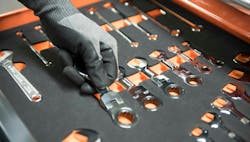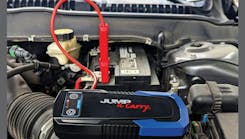Guest Blog: Things to consider when buying a tool set
It is very tempting to judge the value of a tool set by quickly looking at the price and the number of pieces it includes. While this approach may satisfy the needs of do-it-yourselfers who use tools infrequently, the price-per-piece strategy is too simplistic for most professionals to truly assess the value a set will provide. The analysis should go beyond these two parameters and include the following criteria to ensure you’re making a wise investment in a life-long asset.
1. Does the set include the tool sizes I need?
Getting many tools for your money is great, unless you’re not getting the tools you actually need. Check the set’s contents carefully and identify the tools that prompted you to look for the set in the first place.
Ideally, your set should include the tools you use frequently, or else you will have wasted money on tools that go unused and take up valuable space in the toolbox drawer. If the set includes only a fraction of the tools you need, consider a different set, even if you have to pay more, or buy the tools you actually need individually.
It is also important to look at the actual sizes each set includes and identify any missing sizes you need. This is particularly important in the case of sockets and wrench sets that include multiple sizes. Many sets, especially at an entry level price point, include the most popular sizes. However, professionals often use sizes that are not as popular, but badly needed for specific applications.
Pro Tip: Assess your unique requirements and prioritize sets that cater to your specific tool size needs, preventing the accumulation of unused or redundant tools in your toolbox.
2. What type of packaging does the set include?
Packaging is more than just aesthetics. It contributes to the overall value of the tool set. Evaluate how the set is packaged and whether it provides functional organization. Well-designed packaging can enhance accessibility and efficiency, saving you from additional expenses on organizing tools separately. Consider the quality and long-term practicality of the packaging, as it directly impacts the ease of use and maintenance of your tools.
Pro tip: Look for tool sets that prioritize practical and durable packaging, ensuring that your tools remain organized and easily accessible over time.
3. Are the tools manufactured to high standards?
Not all tools are made the same. Some are made with higher quality materials or undergo more manufacturing processes to maximize durability. The best manufacturers also pay attention to fine details, ensuring that their tools operate smoothly and that they fit fasteners securely. These additional steps and extra details are often why one tool may cost more than a similarly looking one from another brand. Like most other things, you get what you pay for. With this in mind, here are a few of the more noticeable indicators of quality:
- How it’s made: Quality hand tools adhere to safety regulations and guidelines established by regulatory bodies or industry associations. This includes considerations for manufacturing, testing, ergonomics, insulation for electrical tools, and other standards designed to minimize the risk of accidents or injuries during use. Reputable manufacturers identify the standards their tools meet on the packaging, website and other marketing material. Some popular regulations are the American National Standards Institute (A.N.S.I), and A.S.T.M. standards.
- How it feels: Ergonomic design is crucial for hand tools to reduce fatigue and strain during extended use. Quality tools often feature comfortable handles with non-slip grips, allowing users to maintain control and leverage without discomfort.
- How it’s finished: There should be no imperfections in a tool’s finish. For instance, there should be no chrome peeling or signs of rust. Quality tools will have a smooth, consistent finish that’s rust resistant.
- How it’s marked: Laser-etched markings on sockets, wrenches and other tools are key to finding the right sized tool in short amount of time. It’s important to make sure the markings are durable and that they won’t easily wear off over time.
Pro tip: Before purchasing tools that could potentially last you a lifetime, spend a little time researching the manufacturer to ensure they follow the highest quality standards.
4. What is the brand's reputation?
In today's global marketplace, any company can claim to sell tools, but a reputable brand stands the test of time. Consider the brand's reputation, which encompasses various intangible factors beyond the tool set itself.
- Warranty process: : A robust warranty reflects the brand's confidence in its products and provides you with peace of mind. Also, consider how easy it is to submit a warranty claim and if the manufacturer will be around for many years to honor the warranty.
- Speed of delivery: Timely delivery is a company’s commitment to the customer. It ensures that you can get to work promptly without unnecessary delays.
- Post-sale support: A brand's willingness to assist customers after the sale is a testament to its dedication to customer satisfaction.
- Availability of spare/replacement parts: Access to replacement parts allows you to extend the life of your tools. Like warranty programs, consider how easy it is to contact the company and if they’re likely to be in business for the foreseeable future.
- Quality of post-service support: Efficient and quality post-service support ensures a positive ownership experience.
Pro tip: Prioritize brands with a long-standing legacy in the tool industry, as their reputation often mirrors a commitment to quality and customer satisfaction.
In conclusion, when purchasing a tool set, go beyond the surface-level comparisons of price and piece count. Assess the practicality of tool sizes, the quality of packaging, the manufacturing standards and the reputation of the brand. A thoughtful and comprehensive evaluation will result in a tool set that not only meets your immediate needs, but also proves to be a valuable and enduring asset.
Information provided by Dynamic Tools.


